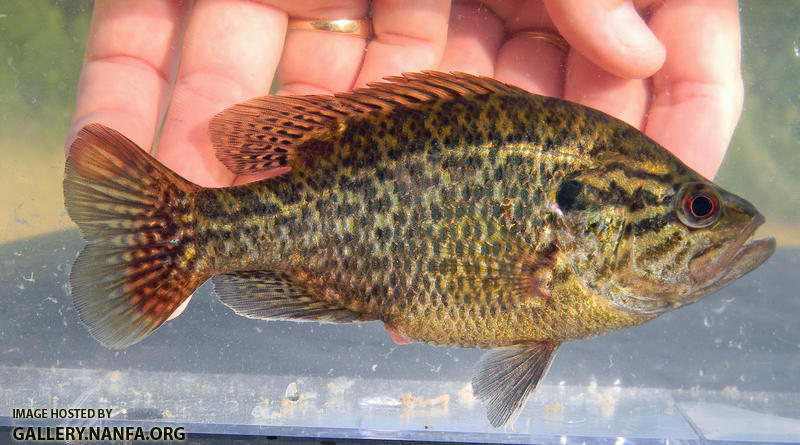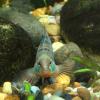Fish from Central China
#41

Posted 02 June 2016 - 07:48 PM
"No thanks, a third of a gopher would merely arouse my appetite..."
#42

Posted 03 June 2016 - 11:54 AM
invasive speicies is a huge problem in Southern China, but not really in my hometown. Rainbow trout and Atlantic salmon were introduced into a reservoir down stream, but they are limited in the reservoir as the water upstream is warm. Largemouth bass was introduced into a small reservoir in south part of my hometown last year as gamefish. I know a lot of anglers, based on the information collected from them. there is no sign that the fish has spread out. Blue gill and blue sunfish are becoming problems in Southern China, while the true problem in Southern China is the invasion of Western mosquito fish, red-eared slider (turtle), and red swamp crawfish. Also some tropical species like tilapia, swordtail and so on. Also, since China is as big as the United States. Invasive species from the same country but different regions is an issue too.
Thank you for your response.
#43

Posted 05 September 2016 - 06:57 PM
Central China is not a place with a good diversity of fish species. In my hometown. One county, we have only about 40-50 fish species, and there is almost no endemic species at all. Well, if you go a little bit south, things are getting better. In fact the more you go south, the more fish species you can find.
The most beautiful species usually come from several particular subfamilies or genera. Like most of the bitterlings from the subfamily of Acheilognathus, pale chubs from the genus of Zacco and Opsariichthys, fresh water goby from the genus of Rhinogobius, paradise fish from the genus of Macropodus. Since we don't have the diversity, I cannot tell you how beautiful they are here. but I will start another topic later to introduce some of them.
Do you know of any Macropodus sp? M. opercularis or M. ocellatus? The latter has done well in latitudes as far north as New Jersey. They are an Anabantoid, a classification which requires surface air to breathe, but apparently do well under the ice for several weeks. I'm guessing the combination of cold water (high oxygen content) and lowered metabolic rate (diminished need for oxygen) allows them to survive.
#44

Posted 27 September 2016 - 08:39 PM
Do you know of any Macropodus sp? M. opercularis or M. ocellatus? The latter has done well in latitudes as far north as New Jersey. They are an Anabantoid, a classification which requires surface air to breathe, but apparently do well under the ice for several weeks. I'm guessing the combination of cold water (high oxygen content) and lowered metabolic rate (diminished need for oxygen) allows them to survive.
Do you know of any Macropodus sp? M. opercularis or M. ocellatus? The latter has done well in latitudes as far north as New Jersey. They are an Anabantoid, a classification which requires surface air to breathe, but apparently do well under the ice for several weeks. I'm guessing the combination of cold water (high oxygen content) and lowered metabolic rate (diminished need for oxygen) allows them to survive.
Yes, Macropodus is well known to Chinese native fish fans. They are remarkable and easy to reproduce in aquarium.
Since my hometown is in the Qinling Mountains, which is rich in creeks. While most Macropodus species prefer still water rather than creeks. I haven't seen them in my hometown and nearby. But just go east a little bit to the north China plain, they are plenty.
There are four species of Macropodus in China, and I have kept all of them before when I was in China.
M. ocellatus 圆尾斗鱼 is the only one you can find in the north, the distribution is from Amur river basin in the north to Zhejiang and Sichuan in the south. This species can also be found as west as even in Xinjiang. Some people say that M. ocellatus can even be found in south Siberia. So it is not suprise to find them doing well in New Jersey. In cold winter, they just stay in the bottom of the water and stay in a kind of dorman state. I think that is the reason why they can survive from the cold winter and also the ice on the surface of water. The appearance of this species is unique and very different from the other three southern species. It has a round caudal fin, the others all have the scissors like caudal fin.
M. opercularis 叉尾斗鱼 is common in south China from south part of Yantze River basin to even Vietnam. It is known to the west as paradise fish.
M. hongkingensis 香港斗鱼is found in Hongkong, Guangdong, Guangxi, Jiangxi and Fujian. the very southern part of China. The shape of this fish is similar to M. opercularis, but not as colorful as M. opercularis. The two species can be found in one region, but M. hongkongensis prefers hill ponds and streams. Because of the habitats in the hills are easy to be isolated, this species has more regional types or you can say subspecies compare to the first two species.
M. spechti 越南斗鱼, can be found in southern Guangxi province and also Vietnam.
All of the four species are able hybridize.
#45

Posted 27 September 2016 - 09:56 PM
Beautiful fish and photos, I picked up a copy of Coldwater Fish in the Home and Garden by Prof. Werner Ladiges (Tetra book) in the early 1980's and I've loved the Zacco platypus ever since. I hope to see them someday in person and catch one on hook and line.
I should also say this book got me interested in keeping a number of coldwater native fish that I was able to catch myself.
Northwest Indiana
#46

Posted 28 September 2016 - 02:35 AM
We can almost always pair up fishes that share similar niches, for example, shiners vs. pale chubs vs tetras, darters vs. gobies vs. darter tetras, and simply make a supplement, there is a group of small stream dwelling catfish in East Asia, Liobagrus sp. , that resembles madtoms in many ways, interesting that both species evolved venom and can sting people. In the attached is a Liobagrus marginatus, picture from Liangjiang and Baidu
What makes me curious is, we know that sunfishes is comparable with cichlids[they share same niche, both are dominant family in their niches], but we can't find a comparable species in Asia in the same niche, the corresponding niche is shared by different Perciformes families like Snakeheads, and Chinese perches.
Attached Files
#47

Posted 28 September 2016 - 07:51 AM
What about Pristolepis species as a surrogate for sunfishes in Asia? They have similar morphology and prefer the same habitat niches. For that matter Anabas may also fit.
Dustin Smith
At the convergence of the Broad, Saluda and Congaree
Lexington, SC
#48

Posted 28 September 2016 - 02:55 PM
Pristolepis and Anabas do have similar morphology with sunfishes, but they have rather small distributions, only in parts of South and SE Asia, they never dominate the niche and whole continent like sunfishes and cichlids do. Perciformes seem to become highly fragmented in Eurosia, IMHO...and I am always wondering what makes sunfishes so successful in NA and also cihlids in SA
#49

Posted 28 September 2016 - 09:44 PM
What about Pristolepis species as a surrogate for sunfishes in Asia? They have similar morphology and prefer the same habitat niches. For that matter Anabas may also fit.
Talking about similar species of sunfish in east Asia, the first thing come out in my mind is a group called Sinipercidae which includes Siniperca and Coreoperca. Sinipercidae is a very close relative of Centrarchidae in East Asia. Most of the Sinipercidae prefer same habitat niche as black basses in north Ameirca. But some of the Coreaperca species like Coreaperca kawamebari in Japan looks very similar to Ambloplites and even to some sunfish like warmouth here.
Coreaperca kawamebari from Saga, Japan picture from ffish.asia

Ozark bass from Arkansas picture from GALLERY. NANFA. ORG
Warmouth picture from GALLERY. NANFA. ORG

#50

Posted 28 September 2016 - 09:59 PM
I am sorry that I spelled Coreoperca as Coreaperca.
#51

Posted 29 September 2016 - 09:29 AM
It is fascinating how some of the fish are similar to North American natives! Now, without straying too far from the topic, are there water snake species there?
#52

Posted 01 October 2016 - 02:34 PM
It is fascinating how some of the fish are similar to North American natives! Now, without straying too far from the topic, are there water snake species there?
It is fascinating how some of the fish are similar to North American natives! Now, without straying too far from the topic, are there water snake species there?
I'm not familiar with snakes, but there is a genus called Enhydris. The Chinese name of this genus is 水蛇属, which means the genus of water snake.
1 user(s) are reading this topic
0 members, 1 guests, 0 anonymous users















